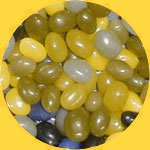Essay 5.2 Experiencing Color Blindness

Color blindness occurs in about 8% of the male population but in only 0.5% of females. As discussed in the activity on Trichromacy, the term color “blindness” is a misnomer. Most people with color vision deficits can distinguish between most light wavelengths, although some wavelengths are indistinguishable.
A web-based company called Vischeck provides a way to simulate what a color picture will look like to someone with various forms of color vision deficits. The pair of images at right demonstrates what the Vischeck engine does. The top image is the original picture, and the bottom image is a simulation of what the picture would look like to someone with deuteranopia (a deficit in which M-cones are missing from the retina). As you can see, reds and greens tend to look alike to a deuteranopic individual.

Use the links below to a) read a short article describing, among other things, how people with color blindness deal with their vision deficits; b) see more examples like the one at right of what the world looks like to color blind people; and c) try the Vischeck engine out on your own images (you might use photographs that you have scanned onto your computer, or you can visit other websites, download images from the sites onto your computer, and run them through the engine).